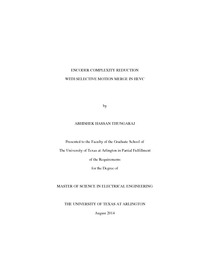
ATTENTION: The works hosted here are being migrated to a new repository that will consolidate resources, improve discoverability, and better show UTA's research impact on the global community. We will update authors as the migration progresses. Please see MavMatrix for more information.
Show simple item record
| dc.contributor.author | Hassan Thungaraj, Abhishek | en_US |
| dc.date.accessioned | 2014-09-17T17:30:33Z | |
| dc.date.available | 2014-09-17T17:30:33Z | |
| dc.date.issued | 2014-09-17 | |
| dc.date.submitted | January 2014 | en_US |
| dc.identifier.other | DISS-12787 | en_US |
| dc.identifier.uri | http://hdl.handle.net/10106/24766 | |
| dc.description.abstract | The High Efficiency Video Coding (HEVC) standard is the latest video coding project developed by the Joint Collaborative Team on Video Coding (JCT-VC) which involves the International Telecommunication Unit (ITU-T) Video Coding Experts Group (VCEG) and the ISO/IEC Moving Pictures Experts Group (MPEG) standardization organizations. The HEVC standard is based on the previous widely used H.264/AVC (Advance Video Coding) standard but includes many new tools and improvements in different key areas which has resulted in achieving a 50% bitrate reduction compared to its predecessor amidst maintaining the same visual quality at a cost of increased complexity.Among the different vital blocks of a video codec the motion estimation and motion compensation blocks are considered as the key and the most complex section. The calculations involving the derivation of motion estimation followed by predictor picture derivation leading to a residual image which is in turn followed by motion compensation using the previously encoded motion information is responsible for consuming a large part of the encoding time and device resource. Since the video signal largely consists of real world objects which have regions of homogeneous motion, the encoder tries to make use of these regions of common motion to bring about a reduction in bitrate. To achieve this reduction the encoder adapts the technique of motion merging which exploit the redundancies among the motion information data obtained through motion estimation. Although the present algorithm used in HEVC is capable of making use of these redundancies they still impose a large computational and encoding time overhead on the codecs affecting the device performance. The thesis proposes an algorithm which selectively performs the motion merging allowing the formation of larger blocks of homogenous motion which reduces the bitrate and also utilizes the typical characteristics of video signal to reduce the encoding time at a cost of little loss of quality. The experimental results based on the proposed algorithm on several test sequences suggest a reduction in encoding time by 14-24%, reduction in bitrate by 2-7% at a little loss of quality by 2-6%. Metrics such as BD-PSNR (Bjontegaard Delta Peak Signal to Noise Ratio), BD-bitrate (Bjontegaard Delta bitrate) are used. | en_US |
| dc.description.sponsorship | Rao, Kamisetty R. | en_US |
| dc.language.iso | en | en_US |
| dc.publisher | Electrical Engineering | en_US |
| dc.title | Encoder Complexity Reduction With Selective Motion Merge In HEVC | en_US |
| dc.type | M.Engr. | en_US |
| dc.contributor.committeeChair | Rao, Kamisetty R. | en_US |
| dc.degree.department | Electrical Engineering | en_US |
| dc.degree.discipline | Electrical Engineering | en_US |
| dc.degree.grantor | University of Texas at Arlington | en_US |
| dc.degree.level | masters | en_US |
| dc.degree.name | M.Engr. | en_US |
Files in this item
- Name:
- HassanThungaraj_uta_2502M_12787.pdf
- Size:
- 1.570Mb
- Format:
- PDF
This item appears in the following Collection(s)
Show simple item record


